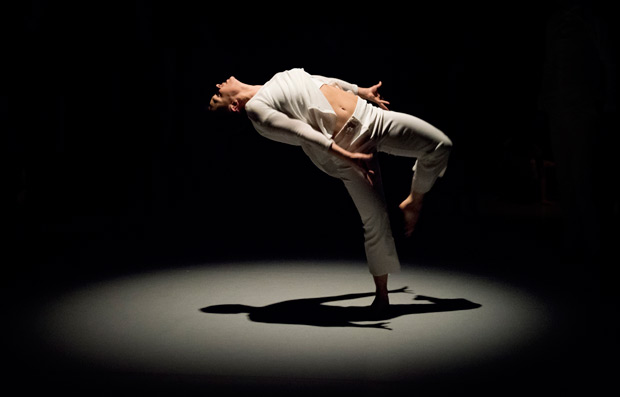
© Camilla Greenwell. (Click image for larger version)
Robert Cohan at 90
Gala evening at The Place
London, The Place
26 March 2015
www.theplace.org.uk
Place page about Robert Cohan
The Place celebrated its founder-choreographer’s 90th birthday with a special gala on the day itself, attended by former colleagues, dancers, teachers, supporters, admirers and friends – a throng of well-wishers, reconnecting and reminiscing about their shared past. The programme, however, concentrated on the here and now, with new works by Cohan himself, as well as by The Place’s associate artists. The young choreographers and performers (some very young) are the promise of the future, building on his achievements.
The opening and closing pieces showed how skilfully Cohan responds to dancers whose training and experience are very different from the Graham-based technique on which he drew for many decades. He was a notable dancer in Martha Graham’s company, creating his own choreography from the early 1950s onwards, and contributing much of London Contemporary Dance Theatre’s repertoire in the 1960s – 1980s. These days, to see what his work used to look like, you have to watch Bob Lockyer’s films for the BBC of LCDT’s performances. Staged revivals, like those for Cohan’s 90th birthday celebrations in London and New York, are rare sightings.
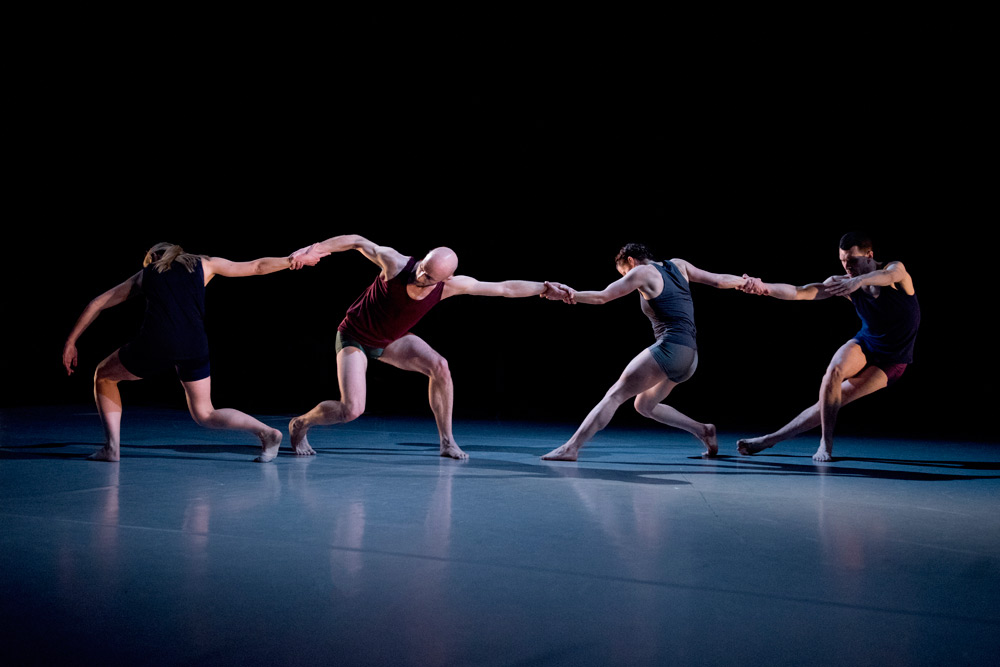
© Camilla Greenwell. (Click image for larger version)
Yolande Yorke-Edgell commissioned Lingua Franca this year for her company (now on tour), in addition to a revival of a solo, Canciones del Alma, from 1978. Cohan based the Lingua Franca quartet on his Agora for LCDT, reworking it for Jonathan Goddard as the central dancer, with Laurel Dalley Smith, Phil Sanger and Yorke-Edgell as his companions. A group of eight dancers warm up at the start as if for Cohan’s Class (1975), though their approaches are all different – yoga, floor barre, Pilates: Goddard briefly adopted a balletic Serenade opening position, feet in first position, arms upraised, before committing to Cohan’s sculptural choreography.
After contrasting duets in counterpoint, first for the men, then a featured one for Goddard and Dalley Smith, the disparate dancers combine in a shared dance language to Bach’s Chaconne in D minor, played by Cohan’s frequent music director, Eleanor Alberga. The quartet is a more intricate piece than the 6-minute solo for Liam Riddick that closed the programme. Set to Elgar’s elegiac Sospiri, Sigh involves a young man undergoing an existential search, running in circles in between being cast down to the ground, striving to rise again. Misty lighting and Riddick’s simple outfit of singlet and loose trousers were designed by Cohan – a complete contrast to the lycra bodytights and dappled side-lighting of the duet from Forest (1977) in the first half of the evening.
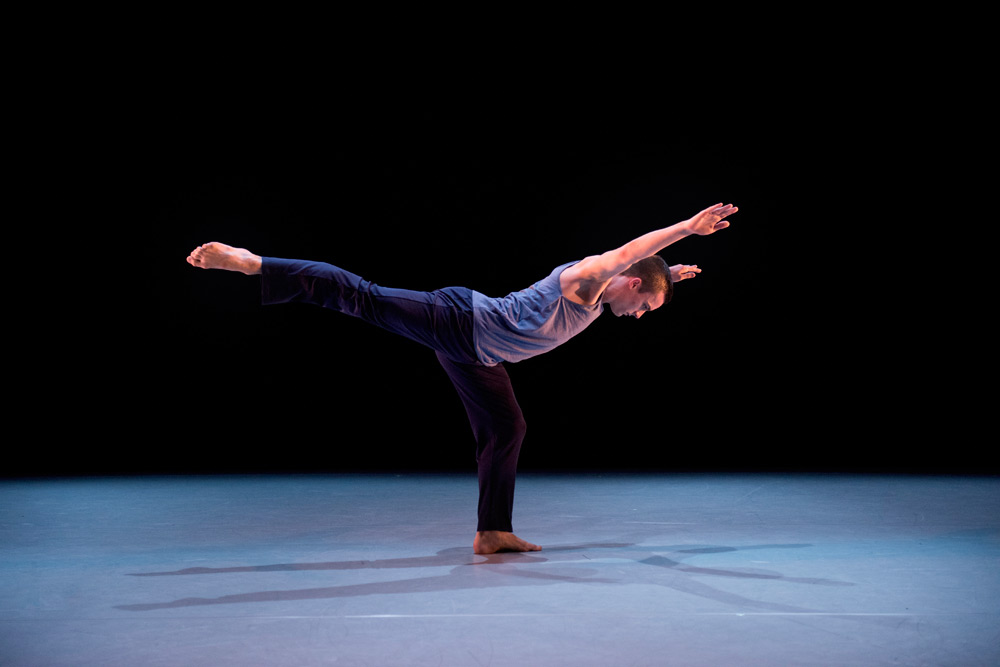
© Camilla Greenwell. (Click image for larger version)
The duet was performed by two members of the present Martha Graham Company in the United States, Charlotte Landreau and Lloyd Knight. (Former LCDT dancers in the roles were in the audience, including Patrick Harding-Irmer and Anca Frankenhauser.) There’s an evident connection with Nijinsky’s Faune in the feral alertness and postures in profile of the man. In Cohan’s duet, he wins over the compliant nymph in a mating ritual as a rainstorm rumbles. The dancers’ sleek lines and sustained control of the shapes they made were an admirable reminder of the discipline of Graham-based technique.
The stillness and precision required were mentioned in a video-ed introduction to Wilderness, a commission based on Forest by Work Place artist Tony Adigun. He conjured up a magical performance, using 24 performers from The Place’s Children and Young Dancers programme as well as students from the Centre for Advanced Training. Impressively confident, they moved rhythmically into squares of light as if among trees, twisting and turning. Like forest creatures, they all had a sense of purpose, from the tiniest to the tallest. Instead of natural sounds, they followed the pulsing phrasing of music tracks by Scandinavian and Uruguayan composers.

© Camilla Greenwell. (Click image for larger version)
James Cousins, the other Work Place artist, was inspired by Cohan’s Cell (1969). Cell was a visceral and cerebral creation about man’s need to escape from the constrictions of society and his own limitations. The original set by Norberto Chiesa, Cohan’s frequent collaborator, was memorable for its oppression and for the flying polystyrene bricks that signalled total destruction at the end. Cousins resorted instead to the density of crowds pressing in on individuals: a horde of grey-clad students from London Contemporary Dance School could have been rush-hour commuters or electronic tweeters, all indifferent to the private agonies of four featured women and two men.
Picked out in white clothing and overhead lighting, the six dancers tried to connect with each other in couples, isolated among an impassive forest of anonymous people. As in Cohan’s Cell, their efforts were ultimately in vain, leaving a lost person standing alone in the darkness. The expert lighting designer was Mickie Mannion, also responsible for Wilderness and for recreating Cohan’s original lighting for his own works.

© Camilla Greenwell. (Click image for larger version
Cohan’s legacy, in addition to recordings of his choreography, is the lasting influence he has left on lighting design for dance, discussed in one his recent seminars. There is to be an annual lecture in his name, starting with his taking part in a debate with Sir Ken Robinson on 11 June 2015. A Cohan scholarship for final year LCDS students was re-launched at the 90th birthday gala. As well as the 1986 history of LCDT by Clement Crisp and Mary Clarke, there is Paul Jackson’s biography, The Last Guru: Robert Cohan’s Life in Dance. That life continues in the studio, where Cohan is still creating and inspiring, as vital as ever. Long may his future birthdays be celebrated by fresh generations of dancers and collaborators.












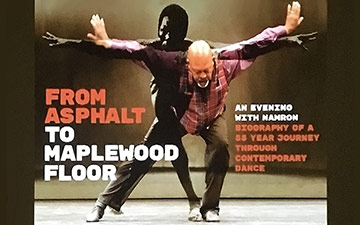

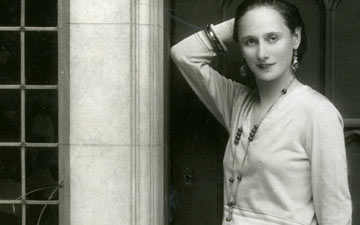

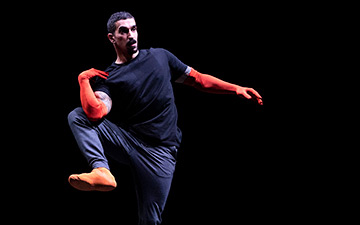
You must be logged in to post a comment.